Michael Fumento
Factual · Powerful · Original · Iconoclastic
The New Band of Brothers
May 29, 2006 · Michael Fumento · Military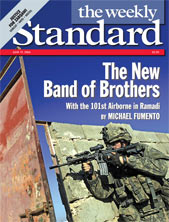
Ramadi, Iraq
Terrorist-infested Ramadi in the wild west of Iraq is for U.S. troops the meanest place in the country, "the graveyard of the Americans" as graffiti around town boast. There is no better place to observe American troops and the fledgling Iraqi army in combat. That’s why I came. When military public affairs asked where I wanted to be embedded, I told them, "the redder, the better" (red means hostile). So they packed me off to Camp Corregidor in eastern Ramadi with the 1st Battalion, 506th Infantry Regiment, 101st Airborne Division (Air Assault). The 506th’s official motto is "Currahee," Cherokee for "stands alone." But they’re better known as the "Band of Brothers" — so dubbed by author Stephen Ambrose and HBO (although the term originally applied to just one company in the regiment).
During the Battle of Fallujah in November 2004, many of the enemy who had vowed to fight to the death, including foreign terrorists, slipped the U.S. cordon. Ramadi, a city of 400,000, was a logical destination. The southwest point of the Sunni Triangle, it lies about 30 miles west of Fallujah and that much closer to Syria — a reliable source of both supplies and foreign jihadists. It’s also the capital of Al Anbar province and a favorite stomping ground of al Qaeda in Iraq, led by Jordanian-born terrorist Abu Musab al Zarqawi until two 500 lb. bombs blew apart his hideout last Wednesday.
To most of the media, Baghdad is where Iraq begins and ends. So naturally, they
think Baghdad is the most dangerous part of the country. Wrong. "The sheer
scale of violence in Ramadi is astounding," wrote
AP’s Todd Pitman after spending
time with several units there. Pitman arrived in Corregidor the same night
I did, after spending a few
previous weeks with the Marines in Ramadi. "One recent
coalition tally of ’significant acts’ – roadside bombs, attacks, exchanges
of fire – indicated that out of 43 reported in Iraq on a single day,
27 occurred in Ramadi and its environs," he wrote in a dispatch. Track the
weekly butcher’s bill for all of Iraq and you’ll
often find that a third to a half of U.S. combat
deaths are in this one city about a third the size of Baghdad.
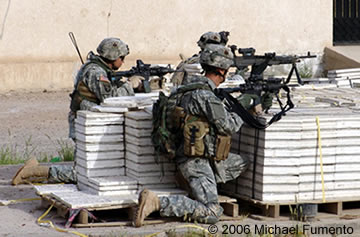
There is no more dangerous city for American soldiers than Ramadi.
Units that go "outside the wire" during the daytime are usually zapped. I went on two day patrols; both times we got hit. Capt. Joseph "Crazy Joe" Claburn, commander of C Company, told me by email after I left: "I have been involved in two firefights in the last two days. We fired over 1,500 rounds of .50 cal [.50 caliber ammunition from an M2 Browning heavy machine gun] and 500 of 7.62mm, 40 rounds of 40mm [40 millimeter grenades] and brought everybody out okay. However, yesterday we had a close friend and Marine hit in the knee. We found out today that he would lose his leg. Does anyone else in Iraq see this on a daily basis?"
There are four minarets within sniping distance of Corregidor, and the gentlemen in these places of worship regularly shoot at the raised observation posts around the camp and sometimes into the camp itself. Mortars as large as 122mm smash into Corregidor on average every other day. I saw a steel container (the kind carried on flatbed trucks and train cars) hit by a mortar; it looked like an aluminum can blown up with a cherry bomb. Improvised explosive devices (IEDs) pop up like mushrooms, and vehicle-borne IEDs delivered by young men determined to get at those 72 perpetually renewing virgins are also a constant threat.
 View video (.wmv, Convex, 1,051kb)
View video (.wmv, Convex, 1,051kb)
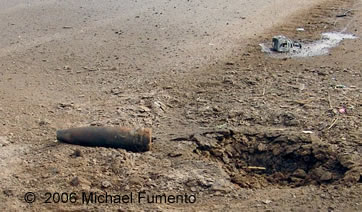
An IED from a 130mm howitzer and the hole from which it was dug up. Photo taken last year near Fallujah.
But here in this hellhole, I found men who would have made their famous World War II forerunners proud. They are no longer paratroopers but are brave, bold, and elite in every sense of the word. The actions of these men in fighting an enemy less skilled than the Germans yet far more vicious and fanatical tell a story that has remained largely ignored. In fairness, Ramadi itself has been mostly ignored.
When it finally made headlines across the country in late May, it was because of bad reporting when the Washington Post’s Ellen Knickmeyer "broke the news" that 3,500 men from the 1st Armored Division in Kuwait were being deployed there as emergency reinforcements for a city essentially lost to the terrorists. Actually, it was 1,500, of whom "some" are "likely to be sent to" Ramadi as the New York Times correctly reported. And the place is bad enough without such exaggerations as the claim by one of Knickmeyer’s sources that al Qaeda runs it.
**Welcome to Corregidor! **
The Iraq war is covered mostly by reporters who hole up in Baghdad hotels and send out Iraqi stringers to collect what the reporters deem news, as an article in the April 6, 2006, New York Review of Books described in great detail. The reporters convert these accounts into prose and put them on the wire. Except for that all-powerful "Baghdad" dateline, they might just as well be writing from Podunk. But you can’t just blame reporters for the non-coverage. I asked military public affairs for 15 days in Ramadi, was told the request had been granted, flew to Baghdad, and only then was informed that I would instead be sent to Fallujah, with a few days in Ramadi to come later. Last year I was also told I would be embedded in Ramadi, only to have it denied entirely once I arrived in Iraq.
Part of the public affairs officers’ reasoning probably is that it’s bad karma to lose a reporter, and Ramadi is a likely place to do so as photographer Toby Morris discovered a few months earlier. While on patrol with the 1st Battalion’s D Company, he tried to photograph some soldiers while standing in the middle of the road. Big mistake. A sniper nailed him in the thigh, shattering his femur. Sgt. Patrick Meyer leaped to drag him to safety, only to be shot himself in the leg while the sniper pumped a third round into Morris, snapping his ankle. Morris now has a rod in his femur and a plate in his ankle. Meyer is still recovering. Soldiers repeatedly told me this story, which initially I thought was meant to get a rise out of me. Later I realized it was intended as a warning; even small mistakes in Ramadi can lead to pain and death.
Corregidor is manned by four companies of 1st Battalion. A and C Companies are the "hunter-killers." B Company guards "Route Michigan" through the city, while D handles heavy weapons. Attached is a tank company from the Pennsylvania Army National Guard and a sapper (engineer) platoon to deal with explosives. There are also "enablers" to assist with the missions, comprising about 100 sailors, Marines, and airmen.
To get there, you take the "Dagger" convoy that travels down Route Michigan from Camp Ramadi (on the outskirts of town). The convoy is preceded by an explosives ordnance disposal unit that painstakingly checks the route for IEDs. On the next Dagger run after mine one such bomb would be found, but there were none this time.
As soon as we pulled into Corregidor and I opened the door of my Humvee, I heard the rattle of machine gun fire. Small arms fire is so common that within days you no longer notice it unless it’s up close and personal. By coincidence, I was accompanied not only by AP’s Pitman but also a third reporter, Army public affairs sergeant Robert . An extremely affable battalion commander, Lt. Col. Ron Clark, debriefed us. He told us that if we were looking for action, we’d find it.
Although firefights and other hostile action are routine, IEDs are the worst problem, he said. They were responsible for five of the six deaths his men have suffered since deploying in January. As of mid-May, the troops at Corregidor had suffered 380 attacks from IEDs while finding and destroying 667 more. Five deaths (and additional injuries) are tragic, but these numbers do counter the misimpression that "ingenious" insurgents are expert in making and laying bombs. In fact, they must expend a massive amount of effort and materiel to do any harm to coalition forces.
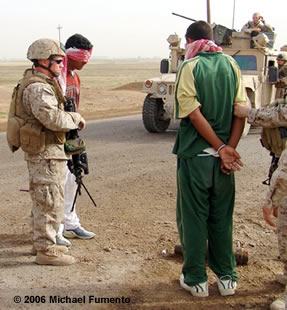
These IED triggermen were captured while a unit I was with was defusing their bomb (seen in a previous photo.)
The best way by far of dealing with IEDs is to keep them from being planted. Several observation posts are set up around Corregidor for that purpose. A spotter sees a guy digging a hole in the road or beside it, and a sniper plugs him. Soon the bad guys catch on and rarely try to plant in viewable areas, concentrating on blind spots. One day Clark’s men found and dispatched 18 IEDs in a stretch of road that couldn’t be seen from the observation posts, he told us. The next day they returned and there were 18 more. So they just placed the road off limits.
Like every officer I spoke with, Clark bemoaned the lack of coverage for the tremendous job his men were doing. Even when Ramadi makes the news, reporters generally manage to overlook 1st Battalion. Two days before I arrived, the enemy launched a coordinated, three-sided attack on the governor’s compound in the Marine sector of central Ramadi, including firing rocket-propelled grenades (RPGs) and machine guns from a mosque and its minaret. Both CNN and the AP covered the event in detail; neither reported that it was actually part of a coordinated series of attacks throughout much of Ramadi including against the 1/506th. Why? The reporters were near the governor’s compound. No reporter; no news.
Clark told us that because attacks are so constant, body armor and helmet are required any time you leave a reinforced-roof building. This is quite inconvenient until you get used to it, and when the temperatures start spiking to 130 degrees I’m sure it’s more than inconvenient. Statum told me he’d been to camps throughout Iraq during the previous nine months and had never seen one with such a requirement. There was good reason for it, though.
Corregidor is roughly the size of a Super Wal-Mart, including parking lot. Buildings and houses outside the perimeter that the enemy could temporarily occupy are so close they could practically heave mortars at us by hand. On average the camp gets shelled every other day. Radar that detects incoming shells supposedly gives you ten seconds to take cover; but I’m told in practice it’s closer to three. Plenty of places in the camp are more than ten seconds from cover anyway. The body armor rule went into effect when the first round of a barrage crashed down about ten meters from the entrance to the headquarters building, killing two men who were seeking cover. You can still see the depression in the thick sidewalk where it landed. When I photographed it, reddish flower blossoms covered it, making it almost appear to be filled with blood.

The deaths by mortar fire of two men at this spot led to the order to wear body armor within the camp.
An added "attraction" is the snipers who occasionally pop off a round into the camp from the minarets. They know of Americans’ unwillingness to attack "religious" buildings, even when they’re clearly being used for military activity. When I asked Col. Clark why Iraqi army or police couldn’t be used to make sure nobody entered the mosques with weapons, he was quick to say, "We never hesitate" to fire back when fired upon. "However," he added, "our fight requires strict cultural and religious sensitivity in order to be successful and legitimize the Iraqi government and army." If, he said, "the Iraqi army and Iraqi police established check points and conducted security screens at mosques it would undoubtedly be viewed negatively by the Iraqi people whose trust is vital to our success."
 View video (.wmv, minaret, 1,023kb)
View video (.wmv, minaret, 1,023kb)
Safe to say, some soldiers wish we were a bit less sensitive. The snipers take shots at the observation posts on a regular basis; though hitting anybody down in the camp would take an extraordinary shot. That said, one night I was walking with a small LED flashlight and cupping it with my hand to make the beam just wide enough to watch where my next footstep would be. I had almost wrenched my knee in a hole earlier in the day and didn’t want to put myself out of commission. Suddenly, "Crack!" A sniper was trying to bean somebody, and I seemed a likely candidate. "Click!" Off went my light.
As I previously reported in these pages ("Back to Fallujah," May 8, 2006), Iraqis on both sides generally are lousy shots. They usually kill through sheer volume of fire and luck. But there are foreigners who definitely know how to aim a rifle and may bring in weapons far more accurate than the standard AK-47.
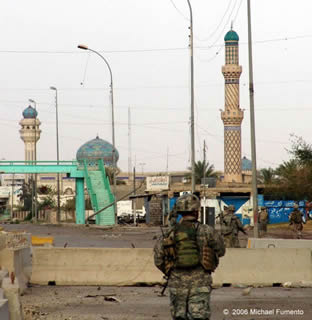
To some these are minarets; to the Americans in Ramadi they’re sniper nests.
The constant threat of snipers and of mortar attacks contributes greatly to the general unpleasantness of life in Corregidor. The camp is also short on amenities, even by Iraq standards. There is no post exchange (PX) packed with necessities and goodies, merely a truck that comes by about once a month. Just a couple of months before I arrived, the camp received its first portable toilets, although the men in some units still have to urinate in one place and go someplace else to finish their business, so that the solid waste may be burned. Chow, I was told, had also been awful, though by the time I arrived it was outstanding. On the other hand, A Company can’t eat in its chow hall because its roof isn’t reinforced and several mortar rounds have torn through and exploded inside. Compared with places like Camp Fallujah — much less the Green Zone in Baghdad – Corregidor is a rat hole.
 View video (.wmv, A Company Mess Hall, 1,736kb)
View video (.wmv, A Company Mess Hall, 1,736kb)
It’s also short on men. Company strength should be 136. C Company originally had 138 men, but because of casualties and normal leave time, Claburn says he’s down to only 102 men available for operations. "Luckily, I have not had any soldiers killed while on the battlefield," he says, but "I have taken a lot of casualties due to IEDs, shrapnel, and bullet wounds. I have close to 20 percent of my company right now eligible for Purple Hearts [awarded for wounds received in combat from hostile forces] if that tells you anything." That means that with his deployment not yet half over, he’s already well below the 80 percent level long regarded as the minimum for operational preparedness.
"The 80 percent issue is legitimate," he says, "but I am under the assumption that I am still required to complete every mission that I am tasked with, despite a shortage of personnel. If that means [soldiers pulling] extra time on the guard tower or another day in OP [observation post] Hotel, or having to pull back-to-back missions, then so be it. That is our job."
For that matter, all Ramadi is tremendously undermanned by coalition forces. With the current numbers, there’s no hope of outright defeating the insurgents, and no Fallujah-style operation seems to be in the works. The Fallujah fight inflicted terrible physical damage on that city, as I observed repeatedly on patrols there, and in any case would be difficult to replicate since Fallujah had two natural barriers against which to pin the enemy, the Euphrates and Tigris, while Ramadi has only the Euphrates. It’s believed such an attack would also permanently alienate the local Sunni leadership, which must play a role in stabilizing the area. Finally, remember that it was the Fallujah fight that made Ramadi what it is today. Do we want to draw in jihadists and gradually kill them or simply scatter them again and let them take up residence elsewhere in the Anbar desert?
 View video (.wmv, Fallujah Damage, 1,861kb)
View video (.wmv, Fallujah Damage, 1,861kb)

Enroute to a firefight, soldiers from A Company and I (yes, the guy in the middle with the camera) look like we’re making a Prince video. (Photo courtesy of Todd Pitman/AP)
Knickmeyer’s May 30 dispatch in the Post featured a selection of quotations from local sheikhs to a nameless Ramadi stringer that made the city sound like al Qaeda headquarters. Claburn went ballistic in reaction: "She spoke so loudly about how the insurgents have control of the city and how they threaten people in this city," he railed. "They do that all around Iraq; why else would we call them terrorists?"
The U.S. strategy in Ramadi is to improve relations with the civilians – who are more sympathetic than you might think because they passionately hate the foreign Arabs and their efforts to impose radical Islam on Iraqis – and to keep the insurgency in check as the size and abilities of the local Iraqi army and police improve. The coalition inflicts grossly disproportionate casualties – 1st Battalion and its support elements routinely kill more jihadists in a day than the entire unit has lost since arriving. Yet this incredible kill ratio is also disturbing. It seems that no matter how readily they’re mowed down, the bad guys just keep on coming and coming.
**Abrams Down! **
Ten days before I arrived, during the night of April 9, 1st Battalion suffered its worst casualties of the deployment in a mini-"Black Hawk Down" situation. An IED flipped a Humvee, killing the driver from D Company. An M-1 Abrams tank went to retrieve it.
 View video (.wmv, Tanks, 1,275kb)
View video (.wmv, Tanks, 1,275kb)
For good reason, Corregidor has a large complement of tanks and other armored vehicles. Unfortunately, another IED made a lucky strike on the tank, cutting the fuel line and setting it ablaze. The men inside scrambled to safety, but now things got really messy.
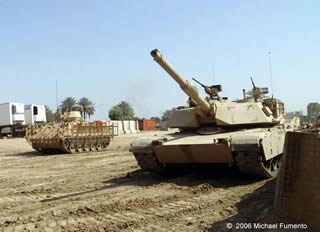
M-1 Abrams tank at Corregidor, with M-113 armored personnel carrier in the background.
You can’t just abandon an Abrams, because it has unique equipment and armor. If the bad guys get hold of a single vital piece they could use it to determine ways of defeating these otherwise almost invincible behemoths. Further, they could sell the information to anybody with a vested interest in blowing up M-1s. You also can’t just call in an airstrike on a tank, as is routinely done with downed aircraft. That’s fine for destroying secret electronics, but blasting a tank just spreads out the parts.
To make things even more dicey, the Abrams carries a powerful 120mm main gun and three machine guns. The rounds for these weapons were "cooking off" in the fire, flying in all directions. They would continue to do so for the rest of the night, making retrieval too dangerous.
So the troops set up a perimeter and waited. As with the real downing of the Black Hawks in Somalia, the burning tank attracted bad guys from throughout the city. They kept pouring into the area to kill the infidels. But with their night-vision equipment and laser pointers, Americans own the night. The enemy came in droves and they died in droves. "The insurgents were so desperate to gain momentum against us that they were literally running into the streets to plant IEDs right in front of us or throwing them over walls," says Claburn. "It was purely amazing." By the time the rounds had stopped flying and the tank was recovered, 30 jihadists were confirmed dead. Disaster had been averted. But the price in blood was high. Two more soldiers from Headquarters Company had died when another IED ripped their Humvee apart. Later the engineers whose job it was to detect and remove IEDs came into Col. Clark’s office, apologizing with tears in their eyes. "I told them you tried; you did your best; but you can’t get all of them all the time," Clark said.
**Firefight at Mulaab **
My first patrol was with A Company, at night. The most exciting event was finding a cow tied up in a backyard. The bad guys had learned their lesson about night attacks. But next up was a day patrol with C Company to Mulaab, an area in southeastern Ramadi pretty much just outside the gate from Corregidor.
For this patrol, we’re joined by 19 Navy SEALs. There seems no reason to have special ops around; apparently they just want to stay in practice. And so they will. We start out in a convoy of Humvees and M-113 armored personnel carriers. The M-113s are given extra protection from RPGs by metal cages (the soldiers call them "cheese graters") that detonate rounds before they strike the hull. We only travel a short distance before the reporters are invited to jump out and join the Iraqi army patrols. These aren’t like the ones near Fallujah, which are split about 50/50 between Iraqis and Americans. Here two Americans are attached to each patrol, but the Iraqis are in charge. These Iraqis seem far more professional than what I’d seen in the Fallujah area. They’ve been repeatedly bloodied, and that makes all the difference.
 View video (.wmv, Iraqi Patrol, 3,109kb)
View video (.wmv, Iraqi Patrol, 3,109kb)
The purpose of the mission is basically knocking on – and if need be – knocking down doors to look for enemy or enemy caches. I feel bad when we do this, but usually the people seem to understand. One woman identifies me as a journalist by my camera and scolds me like an angry chipmunk for violating her home. I just let her vent without telling her "Ma barif Aribi," or "I don’t understand Arabic." Anyway, the kids love us; a girl holds up her littler sister thinking it will provide me with a better photo.
 View video (.wmv, door, 828kb)
View video (.wmv, door, 828kb)
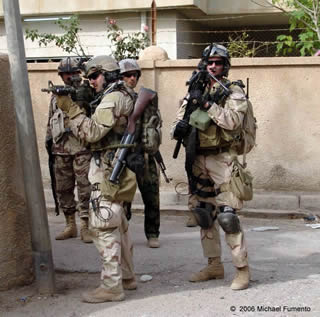
Navy SEALs shortly after shooting begins in Mulaab. Note the wooden-butt 40 mm M-79 grenade launcher, affectionately called a ”Thumper.” On the right is Mike Monsoor, posthumously nominated for the Congressional Medal of Honor after throwing himself on a grenade.
Photographer Toby Morris describes patrols with 1st Battalion as "just intense. You go out and you know something is going to happen." But Capt. Claburn, still an excited kid at 29, tells us how long it will take to happen. He explains that it takes the bad guys about 45 minutes to arrange an attack. "Within 15 minutes the spotters usually come out, and they’ll identify your position," he says. (I’m quoting here from a dispatch by Todd Pitman.) "Within 30 minutes the weapons get brought in," he adds. "And usually about 45 minutes after being on the ground, you can pretty much guarantee that you’re going to get shot at."
You can practically set your watch by the attacks. Just three minutes short of the Claburn mark, a white car bears down on an Iraqi patrol, and a passenger opens up with an AK. "Did I call it or what?" Claburn tells Pitman with a grin as the battle is joined. "Forty-two minutes on the ground. It’s a science."
We break into a house and storm up the stairs to the roof, yelling "Friendly coming out!" so that those ahead of us won’t think we’re, well, not friendlies. No action. So we start back down and all hell breaks loose so we storm right back up.
 View video (Note: video blurred to protect identity of SEALs. Large .wmv file, Mulaab Firefight, 6,701kb)
View video (Note: video blurred to protect identity of SEALs. Large .wmv file, Mulaab Firefight, 6,701kb)
I’m with a number of SEALs, the two other reporters, and Claburn. It’s the right building top. As we take fire, Claburn yells: "Hear them cracking over your head? That’ll get your peter hard, huh?" A SEAL near me has an old wooden-stock M-79 40mm grenade launcher (affectionately called a "Thumper") that was phased out late in the Vietnam war in favor of the M-203, a 40mm tube attached below an M-16 rifle. I had wondered why he’d chosen to carry this but now found out.
Another vehicle is spotted, a flatbed with four jihadists bearing AKs. Claburn and others bring it to a screeching halt with a fusillade of bullets to the engine block; then the SEAL with the Thumper smoothly extracts it from a strap around his waist as if it’s just another appendage and drops the grenade dead center on the jihadists’ truck. One shot; one kill. Those SEALs fight like machines.
In a nice illustration of "the fog of war," one soldier who had a better view than me later said he thought we’d also been attacked by four vehicle-borne suicide bombers and a 12.7mm heavy machine gun. Turns out none of this was true.
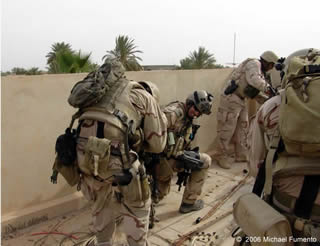
SEALs on the rooftop taking advantage of a break in the action to reload weapons. At fire right is Marc Alan Lee, who weeks later became the first SEAL to die in Iraq.
More bad guys are on the way, and we call in air support, which arrives in the form of two helicopter gunships. We ride out in a Humvee. Troops don’t usually pursue the enemy, we are later told, because this allows the enemy to set ambushes.
But it feels like our day has been cut short. Samuel Johnson once said, "Every man thinks meanly of himself for not having been a soldier." I’d been a soldier for four years, a paratrooper at that. But that wasn’t enough, nor is my first exposure to combat today, because surrounded by bad-ass SEALs on a rooftop I never felt truly at risk. No adrenaline pumped. Plus, I had forgotten in the excitement to put down the camcorder and take photos. I needed another fight. As the expression goes, be careful what you wish for.
**Firefight at OP Hotel **
It’s 7 a.m. We join up with A Company, with whom we’d been laughing and joking the night before. I had teased one amazingly young-looking red-haired fellow, the unimpeachable Spc. Andrew Johnson, asking him if his mother had given him permission to go out and fight with the other boys. He said he was 22 but was used to the ribbing, having been mistaken for a 12-year-old just a few years earlier. It’s nice to go outside the wire with people you’ve already bonded with a bit – not that I wouldn’t trust anybody in the 1/506th to be there for me if I needed them.
We three reporters load into an M-113, and after what barely constitutes a ride we dismount just opposite a former hotel now jokingly called "the Ramadi Inn." In a video a soldier showed me on his laptop, enemy soldiers attacked observation posts on the building. They poured in fire as a diversion, while a dump truck packed with explosives sped towards the structure. The tactic failed. The GIs shot up the truck, which exploded in a massive ball of orange flame. Concussions all around, but no Americans were seriously hurt. To look at the hotel now, though, it seems like one good hard breath would knock it over.
Our combined American-Iraqi force hustles over to the patrol area because we’re now well within range of a minaret and hence snipers – not that our friends with scopes confine themselves to these buildings. (One terrorist sniper in Ramadi was counter-sniped by an American in the Ramadi Inn. The terrorist was firing from a 4th-floor hospital window.)
Even while you’re scanning rooftops for that tell-tale head or glint of sun off a barrel or scope, you’ve still got to carefully watch your feet. "Look out for pressure-plate IEDs!" the soldier in front of me yells back. "What should I be looking for?" I ask. "Anything unusual," he says. "Or really anything at all." Gee, thanks!
 View video (.wmv, Pressure Plates, 2,471kb)
View video (.wmv, Pressure Plates, 2,471kb)
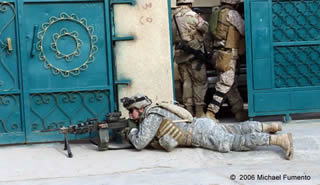
An M240B gunner covers the street while others clear a house.
The Iraqis are supposed to do the main patrolling today, while we enter the taller houses in the area and go up to the roof to provide fire support with machine guns, rifles, and grenade launchers. We always knock or even ring the doorbell first – honest! But no quick response and – bang! – the gates crash in.
 View video (.wmv, Iraqi Patrol, 2,395kb)
View video (.wmv, Iraqi Patrol, 2,395kb)
For some reason, neither doors nor gates ever seem to come down with one blow. One gate absolutely won’t budge, so a large soldier comes and gives it an almighty kick. Crash! Down it goes. The lock and chain held; but the side has pulled right out of the concrete to which it was hinged. Thirty seconds later a guy from next door appears and, even as he’s looking at the damage, he offers us the keys.
Inside the men kick a few doors. As a rule, they don’t rip out of the wall as that gate did; but the locks are usually busted. They’re trying to knock in a really beautiful hardwood one when a woman pops out of nowhere with the key. The soldiers don’t like messing up people’s homes but they also don’t like guys popping out from nowhere and hosing them down with lead. So once you enter a house, each room gets checked.
Once you get to the roof, the first thing you do is lay down a bright fluorescent flexible sheet of plastic. It’s friend-or-foe identification in case air support is called in and you’re not in the mood to have a 500-lb. bomb dropped down your windpipe. Only friendlies know the color of the day.
 View video (.wmv, flag, 1,542kb)
View video (.wmv, flag, 1,542kb)
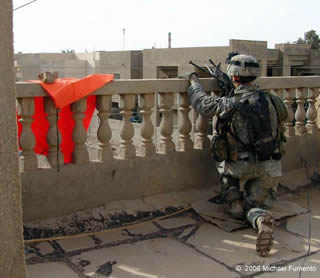
Spc. Robert Killion marks his position a with fluorescent panel to prevent friendly fire from the air.
On the roof of the second house we hear gunfire for the first time today. I ask someone how long it’s been since we dismounted. Damn! Forty-five minutes! Say what you will about the jihadists, they’re punctual.
 View video (.wmv, 45 minutes, 828kb)
View video (.wmv, 45 minutes, 828kb)
The walls are high, which is good protection from snipers but not good for observation. We think we’ve taken rounds directly on our position, but often you just can’t tell. They either sail silently over your heads or smack into the wall too far below for you to know where they hit. We don’t see anything to shoot back at, so we listen to the shooting, joke around a bit, listen to the shooting, joke around some more. We tease one soldier because his smoke grenade had gone off while hooked to the load-bearing equipment on his vest, which strangely enough burned him just below his crotch. Humor relieves tension better than Excedrin.

Shortly after almost taking a sniper round to the head, Killion zaps a jihadist. Note shell casing being ejected to the right just above red spigot handle.
Finally we "exfil" (exfiltrate) to another house when it seems the shooting hasn’t just paused but ended. This would be a feature of the firefight to come. Just when things get peaceful and you think it’s all over, suddenly the enemy starts firing again and with more weapons than before. We occupy the top of another building, which has an accessible roof on the left side and an excellent observation position on the right. I follow a soldier with a machine gun to the right, not knowing of the rooftop position. As I wait patiently to get a photo when he opens up on the jihadists, I’m exposed on my right by windows that go ceiling to floor. There’s only a thin pillar for cover. I try to make myself skinny, but the pillar protects almost none of me. We hear bursts of fire every few minutes, but it’s not until I hear "Way to go Killion!" from the soldier in front of me that I realize it’s Spc. Robert Killion who with his 5.56mm M249 Squad Automatic Weapon (SAW) light machine gun has just zapped a bad guy carrying an AK-47 on a bicycle. I haul tail over to find Killion on the roof, operating with Sgt. Jonathan Falk. Out of four confirmed enemy KIA that day, Killion would get three from his position.
I still needed that photo, so I jokingly order the two men to just pick out some inanimate target and fire while I snapped away. Then – zing! – a sniper round practically takes Killion’s head off. "Holy f—!" he shouts. "Mother f—! That hit right in front of me!" But seconds later, he whoops. "Whew! Yeah!"
 View video (.wmv, Killion, 3,055kb)
View video (.wmv, Killion, 3,055kb)
As I would soon discover myself, Churchill really nailed it when he wrote that "nothing in life is so exhilarating as to be shot at without result." Anyway, Killion gets payback and then some. Shortly another jihadist pops up and with a burst of fire Killion drops him, while I get my photo of him with his brass casings bouncing off my chest.
Now it’s like a bizarre joke; enemy firing stops for awhile and we’re ordered downstairs. But as soon as we start down, the firing starts again and it’s back to the rooftop to fire back. Meanwhile, the machine gunner where I had first been standing on the other side of the building is finally letting loose. So I go back over there and watch a soldier pump three grenade rounds onto the enemy with his M203. The final one strikes home, making it three confirmed KIA from our house. "Right place at the right time!" I’m thinking.
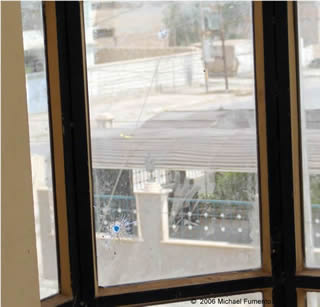
The bullet that came through here had my name on it; fortunately, it was misspelled.
Right place at the right time indeed. I look where I had been standing exposed to the windows. About where my head had been there’s a large pock mark in the opposite wall. The bullet might have drilled me had I remained there; I can’t say.
 View video (.wmv file, Window, 796kb)
View video (.wmv file, Window, 796kb)
Then I see the window. There’s a nice clean hole just where my upper right side was – where my body armor has absolutely no protection, much less the new side ceramic plates everybody in 1st Battalion wears. This puts me in a pensive mood. No Killionesque whoops.
But there’s little time to contemplate my mortality before the order comes to "exfil" for real and start trekking back to the pickup point at a good trot. All quiet on the OP Hotel front. Or so I think. But now it’s going to get really bad.
**The Ramadi Run **
The moment everybody has exited their respective houses the bad guys hit us big time. Machine gun and rifle fire comes from all directions. So it seems, anyway. Maybe this is just because of sound reverberations off the walls and tightly-packed houses; maybe it is coming from all directions. We could pull back into the houses and simply shoot it out all day, but this would greatly endanger the civilians inside. So we take option number two: run like crazy. It’s like the scene towards the end of Black Hawk Down, when the Rangers run the "Mogadishu Mile" while being fired at the whole time before reaching safety in the stadium. I don’t think they ran a mile, and I know we don’t have a mile to go, but it’s going to seem like several.
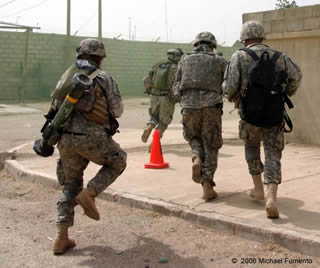
Dodging bullets on the ”Ramadi Run”
Smoke grenades conceal us as we cross the first wide street. After that, the tactic is to have one machine gunner lay down fire from the edge of a building or wall that’s closest to the area we need to cross. Another then darts across until he, too, finds cover and starts laying down a stream of lead towards the enemy position. He’s wearing about 25 pounds of body armor, many pounds more of ammo, and carrying a weapon considerably heavier than the M-16 rifle. But if somebody clocks him he’ll qualify for the Olympics.
Now the rest of us dash across the intersection like squirrels on steroids. It doesn’t matter how much gear you’re carrying, or whether you’ve wrenched a knee or ankle. It doesn’t matter how much junk is lying in your path. Like Peter Pan, you fly. A few guys fire their rifles sideways from the hip towards the enemy as they cross wider areas. You can’t hit anything that way; but if you get an enemy to duck for a few seconds you win.
 View video (.wmv, Street Crossing, 935kb)
View video (.wmv, Street Crossing, 935kb)
I shout out my blood type to the Army reporter, Sgt. Statum, who’s just ahead of me. "I’m O-positive!" They always ask reporters their blood type before patrols. Why did they forget this time? I find an orange dumpster that, with the wall behind me, shields me front and back. But the firing seems to be mainly coming from the side of the dumpster. Gotta keep moving anyway.
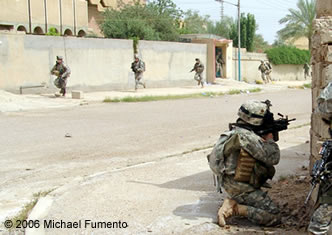
A machine-gunner lays down fire to protect crossing soldiers.
A few minutes later I’m zipping across the street at a non-intersection to join up with the main body of men along a wall. Suddenly a medium machine gun starts hammering away behind me and it sounds so close the barrel could practically be poking me in the butt. A second before, the wall looked five meters away; why does it now look like five miles? I drop onto the road and make like a squished bug, then immediately start rolling to the wall. Not forgetting my mission, I keep my video camera up (the footage makes you dizzy), but probably two dozen GIs see me drop and are sure I’m hit. "Holy s—! holy s—!" one shouts. There goes another embed.
 View video (.wmv file, Fumento Hits the Dirt, 2,844kb)
View video (.wmv file, Fumento Hits the Dirt, 2,844kb)
One brave soul, who proved to be Sgt. Falk, risks his hide by jumping from his relatively safe position along the wall to pull me in. "I’m just taking cover!" I yell. But he’s determined to rescue me, even as my rolling and the lack of a handle on my body armor makes it impossible for him to grab me. That I wasn’t actually hurt makes him no less a hero in my book. When I get to the wall I stand erect so everybody can see I’m okay.
 View video from Todd Pitman (.wmv file, Streetfight, 617kb)
View video from Todd Pitman (.wmv file, Streetfight, 617kb)
Then a soldier slips and all eyes turn to him. He’s okay. He just needs water. I offer him the nozzle of my Camelbak water bladder. Having broken a promise to myself that no soldier would risk his life for me, I feel good giving just a little something back.
I don’t see it myself, but apparently while we catch our breath beside one wall machine gun fire tattoos it above us, dropping bits of concrete on guys’ heads. Thank heaven for the tendency of the Iraqis (sadly ours as well as theirs) to shoot high. I’m far too busy trying to stay alive to have time to be scared. And so we go from wall to wall, across alleys, streets, and open spaces that look forever long.
As we approach our pickup area and relative safety, I come across an Iraqi soldier with blood streaming from his face onto his body armor. "Medic!" I yell. To the first American soldiers who see him it appears it was just a bad nick. But – bizarrely enough – he’s taken a ricochet round sideways through the nose.
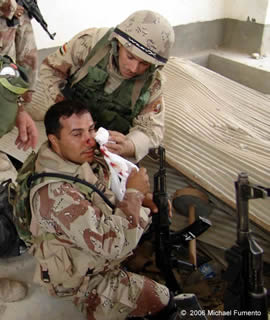
A ricochet bullet has made this ”The Man with Four Nostrils.”
Finally we approach a protected position near where we dismounted, with concrete on top and one side. Safe at home? Not yet. "Incoming!" somebody yells, and we dive that few extra feet for cover. There is an explosion in the distance and we see a plume of smoke. But it turns out to have been some joker trying to scratch the paint on an Abrams with an RPG round.
The tank from what I see arrives too late, but we do have support from the .50 cals on the M-113s. Nothing comes from the air until we reach the safe point, when a fighter jet swoops over and flies off. The rules of aircraft engagement are tough within Ramadi city limits for two reasons. First, it’s heavily populated and it’s all too easy to accidentally kill civilians. Second, with more and more joint American-Iraqi patrols it’s also too easy to kill friendlies. But the Iraqi soldiers don’t necessarily understand this. Knowing I was a sahafi, a reporter, one points to his nasally impaired friend and then to the departing jet and tells me, "Ameriki [Americans] no good!"
Well, excuse me! The Iraqis did perform admirably by their standards. They held their positions and suppressed enemy fire. But without our guns, they’d have taken terrible losses. As is, other than the nose shot, only one Iraqi soldier was injured, in the calf, and he was evacuated from the battle zone immediately and presumably under heavy fire. Amazingly no Americans were injured. The other reporters’ cameras did catch me slamming into the street so you could say I wasn’t a casualty but I played one on TV.
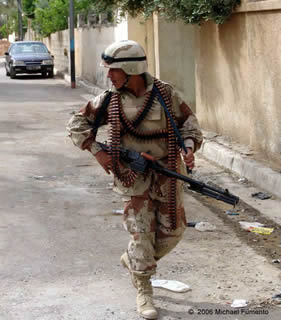
Iraqi soldiers seemed much more competent in Ramadi than those I patrolled with in Fallujah. This one is carrying a BKC 7.62mm medium machine gun.
In the M-113 on the way back, you might have expected a sort of stunned silence, yet there was anything but. The sounds were of excited chatter and outright laughter. Later, as we reporters looked at each other’s video footage, we laughed all over again. It’s hard to explain. The laughter is partly in relief. And keep in mind that we knew nobody had even been badly hurt on our side. But it was also like the best amusement park ride you’ve ever been on times ten. Churchill was right. All three of us reporters immediately inquired as to whether there would be another patrol that afternoon or the next day, only to find that patrols had been halted because of an upcoming operation that ultimately never took place. But I was intrigued that several people during the day said to me, using almost the exact words, "Heard you had fun out there today!"
And yes, it was strangely thrilling for the soldiers as well. "I don’t think we’ve been under heavy fire like that before," Pfc. Tony Wickline of A Company told me. "I mean, we’ve been shot at a lot but today . . . " Then he just started shaking his head and muttering: "Uh, uh, uh, uh, uh." I don’t think I really appreciated the events of that day until I got home and watched my video, doing so when my wife wasn’t around. Before it ended I put my head in my hands and trembled.
**Letters from Home **
After I left Ramadi, I began receiving emails from relatives of the troops, grateful for the photos and stories I had posted on my blog. They are a reminder of how pitifully little coverage the fighting men in Ramadi have received. "My son is in Camp Corregidor," wrote one, "and these are the first really decent pictures of the area I have seen. . . . He doesn’t say much about the conditions, so I have to prowl the Internet to find what I can. He doesn’t want his mom and dad to worry more than we have to."

Sgt. Robert Statum and I check out M-14 rifles, while Pfc. Tony Wickline looks on. And at far right, those fabulous fingers of Jennifer Vickers’ husband.
Another, from a wife whose husband recently departed the area: "I couldn’t figure out why if it was so dangerous there, where was the news? Rarely did you ever hear Ramadi mentioned, yet I knew the danger that was there." A third: "It’s hard to talk [to my husband] on the phone and not be able to know what he is doing or what all is happening. . . . Just hearing what they are going through for our country makes me so proud that I married into the military!"
Jennifer Vickers thanked me for a photo that showed little more than the fingers of her A Company husband along one edge. But that was a lot more of him than she’d seen in a long time. A mother wrote that her son "can not say what he does. All I get is ’I am good’ but he sounds tired. You gave me some insight into his life." It was signed, "Scared mom of Spc. [omitted]."
The letters seemed to reflect the same sense of purpose I saw in the men of 1st Battalion and its support elements at Camp Corregidor. Life is hard, death and injury are always just around the corner, and the men know that when they leave they’ll simply be turning the sector over to a new unit. No peace treaty signing on the deck of the U.S.S. Missouri.
I pointed out to Claburn that Shakespeare wonderfully captured the feelings of men who have fought together and relied on each other in the face of death when he wrote:
_We few, we happy few, we band of brothers;
For he to-day that sheds his blood with me
Shall be my brother; be he ne’er so vile. _
But the Bard was specifically describing the soldiers of Henry V celebrating a devastating and historic defeat of the French at Agincourt. There would be no such clear-cut victory in Ramadi for the New Band of Brothers. Claburn disagreed: "Every day we go out into the Mulaab, we experience a victory. The blood and sweat that is earned will forever live with them, and the stories we share – the stories we few share – will only be understood by those who were there. You have experienced the sheer terror of not knowing if you’d make it back to the safety of the concrete barriers and sandbagged roofs of Camp Corregidor. These men do it every day and without question. They do it and they love the victory we share against the enemy."
